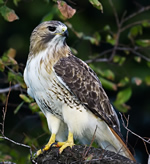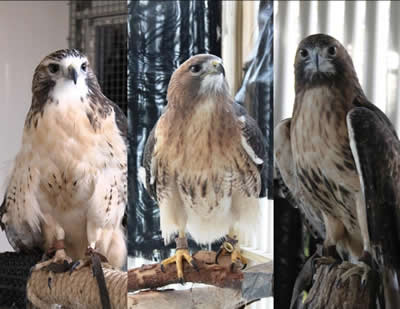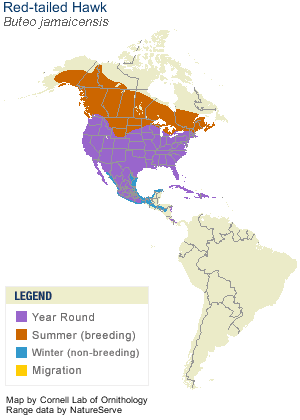
 Red-tailed Hawk
Red-tailed Hawk
Buteo jamaicensis
Education birds representing this species: Alba, Henna, and The Professor.
Alumni: Leoti, Lutah and Dusty (Dusty housed on Exhibit Trail)

l to r: Alba, The Professor, and Henna
Interesting Facts:
- Most wide-spread in North America
- There are five sub-species - difficult to tell apart!
Physical Dimensions:
- wing span ~4 - 4.5 feet
- weight ~1.5 to 4 pounds
Prey (often able to stay year round because of variety of diet - no need to migrate)
- Mostly small mammals (mice, rabbits, squirrels, rats)
- birds
- bats
- snakes
- crayfish
- fish
- amphibians
- insects
- dead animals (carrion)
Hunting Techniques:
- Stoop on prey from above (riding thermals or a high perch)
- Chase prey in direct flight
- Surprise prey
- Hover hunt
- steal from less aggressive raptors
Range:
- North America and Central America
- Only migrates if food is unavailable (usually younger birds migrate, older stay and defend a territory)

Color:
- no sexual dimorphism (when males and females differ in coloring). Sexual dimorphism is unusual in raptors.
- extreme range of color in individuals (can be dark as a golden eagle, and so light its thought to be albino)
- It's rare to see a red-tailed hawk in transition as it develops it's signature red tail (click here to see a photo and more information)
Reproduction:
- Builds nest of sticks woven together to form a cup - in trees, on cliffs, utility poles, buildings, etc.
- Builds a nest in March-June
2-3 eggs
incubation for 28-35 days
Fledged after 42-46 days
Independent of parents 3+ month - Young are vulnerable to Great Horned Owl, bobcats, foxes and coyotes
Conservation:
- No conservation issues - not endangered, but often victim of human persecution (poisoning)
- Has taken advantage of deforestation and urban sprawl (golf courses and roadsides are good for hunting)
Links and Downloads:
- Research about Red-Tailed Hawks movements at and around O'Hare Airport
- Newspaper Article about O'Hare Airport research
- New York Times article about longevity in Red-tailed Hawks:
http://www.nytimes.com/2010/12/20/nyregion/20towns.html?ref=peterapplebome
- Compiled data on populations of Cooper's Hawks and Red-Tailed Hawks by Ron Skleney NEW!!